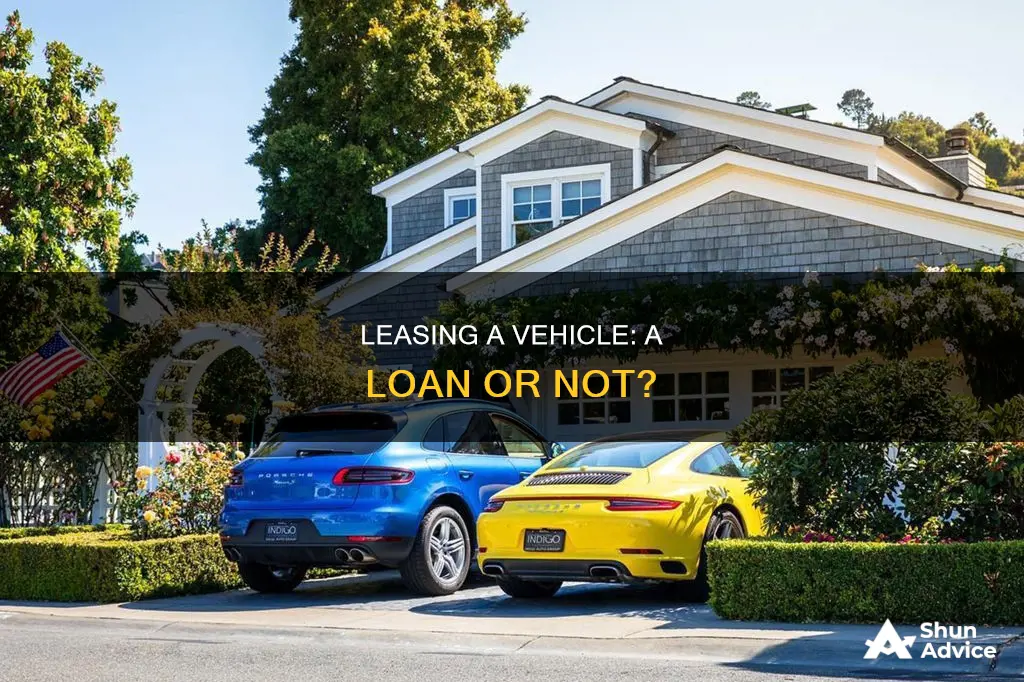
Leasing a vehicle is often compared to taking out a loan, but they are fundamentally different. Leasing a car is more akin to a long-term rental, where you pay for the privilege of driving it for a set period and mileage. In contrast, a loan involves borrowing money from a financial institution to purchase a car, which you then own and build equity in over time. While leasing may offer lower monthly payments and the ability to drive newer cars, it comes with restrictions and additional fees, and it is often considered a debt. On the other hand, loans provide eventual ownership and the freedom to customise your vehicle, but they may result in higher monthly costs. Understanding these differences is crucial when deciding whether to lease or take out a loan for a vehicle.
| Characteristics | Values |
|---|---|
| Nature of the agreement | Leasing a vehicle is like renting it, while a loan is a financing agreement to eventually own it. |
| Monthly payments | Leasing typically has lower monthly payments than a loan. |
| Mileage | Leasing usually comes with mileage restrictions, while a loan allows you to drive as many miles as you want. |
| Customization | Leasing does not allow for vehicle customization, while a loan does. |
| Maintenance and repairs | Leasing often covers maintenance and repair costs. |
| Ownership | A loan leads to eventual ownership, while leasing does not build equity. |
| Termination | Getting out of a lease agreement is more difficult and usually involves penalties. |
| Length of agreement | Leases are typically shorter than loans, allowing for more frequent upgrades to newer models. |
| Tax advantages | Leasing may offer significant tax advantages for business owners. |
What You'll Learn

Leasing a vehicle is like renting, with monthly payments
When you lease a car, you are paying for the privilege of driving it for a set amount of time and miles, and you are not building equity in the car. This means that when the lease ends, you have to return the car and you won't have any equity to use towards another vehicle.
Leasing a car can be a great option for those who want to drive a new car while keeping monthly payments affordable. Lease payments tend to be cheaper than car loan payments, as you are only paying for the estimated depreciation of the car's value while you drive it. This means that you can often access vehicles that may be more expensive to buy.
Leasing also offers the ability to upgrade to a new car every few years, as leases tend to be much shorter than the length of auto loans. This can be a good option for those who live in an area for a short time, such as students, as you can simply return the car when you are ready to leave.
However, it is important to note that leasing a car can come with some drawbacks. For example, there are often mileage restrictions and extra fees for wear and tear. Additionally, you cannot make any customizations to the car, as it does not belong to you.
Relocating for Residency: Laurel Road and Loan Options
You may want to see also

You don't own the vehicle at the end of the lease
When you lease a car, you are essentially paying for the privilege of driving a new car model every few years without having to worry about selling your old one. However, this comes at the cost of not owning the vehicle at the end of the lease.
Leasing a car is like entering into a long-term rental contract. You get to drive the car for a set period, usually a few years, and then you return it to the dealership. This means that you don't have the hassle of trying to sell the car or find a buyer when you're done with it. It's a great option if you're only going to be living in an area for a short time, like when you're away at college.
The main difference between leasing and taking out a car loan is that a loan leads to eventual ownership, while a lease does not. With a lease, you're paying for the estimated depreciation of the car's value while you drive it. This means that you're not building equity in the vehicle, and you won't own it even after you've finished paying off the lease. The car remains the property of the lease finance company.
Because you don't own the leased vehicle, you are not allowed to make any customizations, such as adding a new stereo system or painting the car. You also have to abide by mileage restrictions and return the car with no more than "normal" wear and tear. If you exceed the mileage limit or return the car with excessive damage, you'll likely have to pay a fine.
Koha's Interlibrary Loan System: How Does It Work?
You may want to see also

You can't customise a leased vehicle
Leasing a car is similar to renting a car. You pay for the use of the car during the lease period, which can be anywhere between 24, 36 or 48 months, instead of paying the full purchase price. At the end of the lease, you can either choose to buy the car at a predetermined price or return it to the dealership.
Leasing a car comes with certain restrictions. One of the most important restrictions is that you cannot customise or modify the vehicle. This is because the leased vehicle doesn't belong to you, and you are expected to return it in its original condition at the end of the lease period.
While some sources state that you cannot make any customisations to a leased vehicle, others suggest that there are some reversible modifications that are allowed. These include non-invasive modifications that have no lasting impact on the vehicle and can be easily removed or rectified. This includes upgrades on the inside of the vehicle, such as installing seat covers, new floor mats, or steering wheel covers. You can also add removable aftermarket accessories, such as vinyl wraps or removable decals.
It is important to carefully read and understand the restrictions and provisions in the lease contract before making any modifications. Any permanent changes, such as painting the vehicle or adding a new stereo system, are not allowed. You must also be mindful of the warranty implications of any modifications. If the lease includes a warranty, you may be covered for some repairs, but customisations could void this.
In summary, while there may be some limited opportunities to customise a leased vehicle, it is generally not allowed. This is because the vehicle must be returned to the dealership in its original condition at the end of the lease period.
Lake Trust Equity Loans: What You Need to Know
You may want to see also

Mileage limits and extra fees for wear and tear
When leasing a car, it's important to be aware of the mileage limits and potential extra fees for wear and tear. Mileage limits are a common feature of car leases, and if you exceed the agreed-upon limit, you will likely be charged a per-mile rate or face other penalties. These charges are outlined in your lease agreement, and it's important to carefully review this document to understand your responsibilities and potential costs.
Exceeding the mileage limit is not the only circumstance that can result in additional fees. "Normal" wear and tear is expected, and some leases cover the cost of maintenance and repairs to help manage this. However, excessive wear and tear can result in extra charges at the end of your lease. To determine whether your vehicle has excessive wear, you can refer to tools and guidelines provided by the leasing company, which outline the dimensions of normal wear.
It's worth noting that repairs completed prior to the end of your lease agreement can help protect against these additional charges. Some leases may also offer repair coverage through the manufacturer's warranty, which can mitigate unexpected costs. However, it's always a good idea to carefully review the specific terms of your lease agreement to understand your responsibilities and potential costs associated with mileage limits and wear and tear.
While lease agreements may impose certain restrictions and potential fees, they also offer benefits such as lower monthly payments, the ability to drive newer cars more frequently, and access to the latest features and technologies. Ultimately, the decision to lease or pursue other options, such as taking out a loan to purchase a car, depends on your individual needs, preferences, and circumstances.
Lazada's Loan Services: What You Need to Know
You may want to see also

Leasing is a good option if you want to drive a new car every few years
Leasing a car is a good option if you want to drive a new car every few years. It is a long-term rental contract for a new car, and at the end of the lease, you can either return the car or buy it at a predetermined price. Leasing allows you to drive a new car with the latest features and technology every few years without the need to commit to a specific vehicle or take out a long-term loan.
Leasing can offer lower monthly payments than financing a car, as you are only paying for the use of the car during the lease period, which is typically two to four years. This makes it a more affordable option for those who want to drive a new car without the high monthly costs associated with buying one. Additionally, with leasing, you don't have to worry about the hassle of selling your car when you're ready for a new one.
Another advantage of leasing is that it often includes repair coverage, as most leased vehicles are still under warranty. This means that if you encounter any expensive repairs, they are likely to be covered. Leasing can also provide tax benefits, as the Internal Revenue Service (IRS) allows you to deduct both the depreciation and financing costs from your monthly payments.
However, it's important to consider the drawbacks of leasing. One significant disadvantage is the mileage restrictions and the potential for additional fees if you exceed the mileage limit. You may also be charged extra for wear and tear beyond what is considered normal. Additionally, with leasing, you won't build equity in the vehicle, and you won't own it at the end of the lease unless you choose to buy it. Early termination of a lease can also result in hefty penalties.
Overall, leasing is a good option for those who prioritize lower monthly payments, want to drive a new car with the latest technology every few years, and don't mind the limitations and restrictions that come with leasing. It offers flexibility and access to newer cars without the long-term commitment of buying. However, it's important to carefully consider the terms and conditions of the lease, including mileage limits and potential fees, to ensure it aligns with your driving habits and financial situation.
Cosigning a Lease: Impact on Future Loan Eligibility
You may want to see also
Frequently asked questions
When you take out a loan to buy a vehicle, you own the car once your payments are made and can keep it indefinitely. With a lease, you are essentially renting the car for a set period and will need to return it to the dealership at the end of the lease.
Leasing a vehicle often means lower monthly payments than with a loan, and you get to drive a new car every few years. Leases also tend to include maintenance and repair costs, and the latest safety features.
With a lease, you are typically restricted to a certain number of miles per year, and you may be charged fees for excessive mileage and wear and tear. You also won't build any equity with a leased vehicle, and you may end up paying more in the long term.
Getting out of a lease agreement can be difficult and usually involves paying hefty penalties. The earlier you end the agreement, the more expensive it will be.







